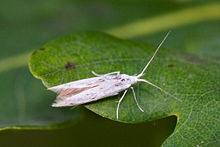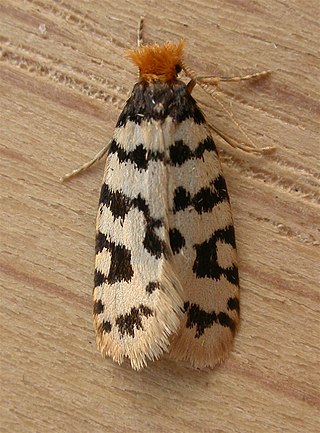
The Psychidae are a family of the Lepidoptera. The bagworm family is fairly small, with about 1,350 species described. Bagworm species are found globally, with some, such as the snailcase bagworm, in modern times settling continents where they are not native.

Oecophoridae is a family of small moths in the superfamily Gelechioidea. The phylogeny and systematics of gelechoid moths are still not fully resolved, and the circumscription of the Oecophoridae is strongly affected by this.

The Elachistidae are a family of small moths in the superfamily Gelechioidea. Some authors lump about 3,300 species in eight subfamilies here, but this arrangement almost certainly results in a massively paraphyletic and completely unnatural assemblage, united merely by symplesiomorphies retained from the first gelechioid moths.

The Gelechiidae are a family of moths commonly referred to as twirler moths or gelechiid moths. They are the namesake family of the huge and little-studied superfamily Gelechioidea, and the family's taxonomy has been subject to considerable dispute. These are generally very small moths with narrow, fringed wings. The larvae of most species feed internally on various parts of their host plants, sometimes causing galls. Douglas-fir (Pseudotsuga) is a host plant common to many species of the family, particularly of the genus Chionodes, which as a result is more diverse in North America than usual for Gelechioidea.

Gelechioidea is the superfamily of moths that contains the case-bearers, twirler moths, and relatives, also simply called curved-horn moths or gelechioid moths. It is a large and poorly understood '"micromoth" superfamily, constituting one of the basal lineages of the Ditrysia.

The Batrachedridae are a small family of tiny moths. These are small, slender moths which rest with their wings wrapped tightly around their bodies.

The Blastobasidae are a family of moths in the superfamily Gelechioidea. Its species can be found almost anywhere in the world, though in some places they are not native but introduced by humans. In some arrangements, these moths are included in the case-bearer family (Coleophoridae) as subfamily Blastobasinae. The Symmocidae are sometimes included in the Blastobasidae as subfamily or tribe.

Scythrididae is a family of small moths in the superfamily Gelechioidea. The family is sometimes included in the Xyloryctidae as a subfamily Scythridinae, but the Xyloryctidae themselves have sometimes been included in the Oecophoridae as subfamily. Scythrididae adults are smallish to mid-sized moths, which when at rest appear teardrop-shaped.

Pterolonchidae is a small family of very small moths in the superfamily Gelechioidea. There are species native to every continent except Australia and Antarctica.
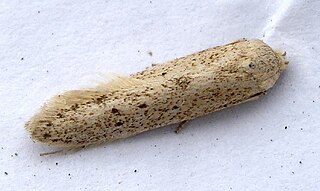
Blastobasis is the type genus of the gelechioid moth family Blastobasidae; in some arrangements these are placed in the case-bearer family (Coleophoridae) as a subfamily. Within the Blastobasidae, the subfamily Blastobasinae has been established to distinguish the Blastobasis lineage from the group around Holcocera, but the delimitation is not yet well-resolved.

Chedra is a genus of tiny moths, belonging to the family Batrachedridae.

Coleophora ibipennella is a moth of the case-bearer family (Coleophoridae). It was first described by Philipp Christoph Zeller in 1849 and is found in Asia, Europe and North Africa. The larva feed within a pistol case on oak leaves and in the past was confused with Coleophora betulella, whose larva feed from a similar looking pistol case on birch leaves.

Taleporia is a genus of small moths. It belongs to the bagworm moth family (Psychidae). The "wastebin genus" Solenobia is technically a junior synonym of the present genus, but most of the species formerly placed there actually belong to other genera of subfamilies Taleporiinae and Naryciinae.

Crassa is a genus of the concealer moth family (Oecophoridae). Among these, it belongs to subfamily Oecophorinae. The genus name Tichonia, established by J. Hübner in 1825, was frequently misapplied to these moths by earlier authors. But as the type species of Hübner's genus is the greenweed flat-body moth – originally described as Tinea atomella, but nowadays called Agonopterix atomella –, Tichonia is actually a junior synonym of Agonopterix. That genus does belong to the same superfamily as Crassa, but is placed in the concealer moth subfamily Depressariinae which is sometimes treated as distinct family.
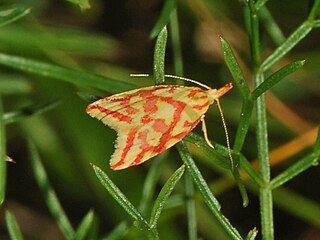
The Amphisbatinae was a small subfamily of moths in the superfamily Gelechioidea. Like their relatives therein, their exact relationships are not yet very well resolved. The present lineage is often included in the Depressariinae as a tribe Amphisbatini, though more often within the context of a "splitting" approach to Gelechioidea systematics and taxonomy, wherein the Depressariinae are elevated to full family rank and the Amphisbatinae are treated as a subfamily therein. An even more extremely split-up layout even treats the Amphisbatinae as full family Amphisbatidae. In the scheme used here, the Amphisbatinae are included in the Oecophoridae as a subfamily alongside the Depressariinae.
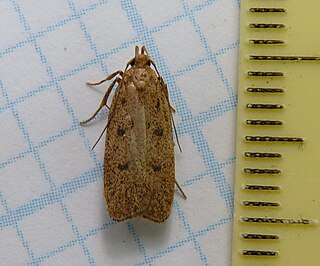
The Symmocinae are a subfamily of moths in the superfamily Gelechioidea. These small moths are found mainly in the Palearctic and Africa.

Scythris is a genus of gelechioid moths. It is the type genus of the flower moth family, which is sometimes included as a subfamily in the Xyloryctidae, or together with these merged into the Oecophoridae. The genus was erected by Jacob Hübner in 1825.

Luquetia is a moth genus of the superfamily Gelechioidea described by Patrice J.A. Leraut in 1991. It is mostly placed in the family Depressariidae, which is often – particularly in older treatments – considered a subfamily of the Oecophoridae or included in the Elachistidae.

Chedra delector is a tiny moth placed in the family Batrachedridae. The Global Lepidoptera Names Index of the Natural History Museum in London classifies it in the family Coleophoridae based on the old classification given by Ron Hodges in the 1983 Check List of the Lepidoptera of America North of Mexico. It is found in Chile. The holotype was collected by D. Bullock on 30 January 1941 at Angol, in the Malleco Province, central Chile, and is kept at the Department of Entomology of the National Museum of Natural History of the Smithsonian Institution. The species was described by Ron Hodges in 1966. The caterpillars feed upon the seeds of Cyperaceae.
Epimarptidae was a former, or is a possible, monotypic family of moths in the moth superfamily Gelechioidea. It can now be seen as either a synonym of family Batrachedridae, or a monotypic subfamily of that family.
